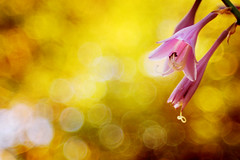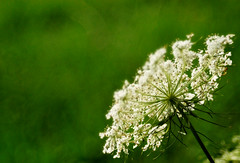Depth of Field (DOF) refers to how much of your image is in focus. With a shallow or small DOF, only a small part of the image is in focus and with a wide or large DOF, a large portion, if not all, of your image is in focus. Generally, a shallow DOF is desired for portraits and macro photography and a large DOF is best for landscape photography.
Bokeh refers to the out of focus (OOF) parts of your image. I like to define bokeh as "quality blur." Bokeh can be just as important as whatever is in the field of focus (DOF) and can take on different appearances with small changes in things like lighting and aperture.
The two most important factors in creating the look of a shallow DOF with bokeh are aperture and distance. Aperture refers to the opening in your lens which controls the amount of light that is allowed into the image. The size of the opening is measured in f/stops. The smaller the f/stop number, the larger the opening and vice versa. The larger the opening (smaller f/stop) the more light that is allowed in and the smaller the DOF you are able to achieve.
small f/stop = large aperture/opening = small DOF = more bokeh/blur
large f/stop = small aperture/opening = larger DOF = less bokeh/blur
Often, the further away your background is from your subject, the more bokeh you will be able to achieve. Playing with distance is something that those of you with point and shoot cameras will be able to do even if you can't control your manual settings. If you do have a p&s, play with different settings to see what gives you the best bokeh/smallest DOF. The macro setting and portrait settings are good places to start. I find that if I get as close to my subject as possible, the better bokeh I can get in the distance.
Here are some examples of how settings can affect your DOF and bokeh. This is the same shot and the exposure is consistent. The settings were the only changes made. Notice how the DOF gets smaller as the f/stop gets smaller.
f/11 ss 1/40

f/5.6 ss 1/160

f/2.8 ss 1/800

If you have the ability to shoot manually, it is always best. If not, shooting in aperture priority is a great way to learn how aperture affects your images. Play with light and distance, along with aperture, to see the different types of bokeh you can achieve. There's smooth and silky bokeh and fun and bubbly bokeh - the possiblities are endless!!
That concludes today's lesson! Get out and shoot!









No comments:
Post a Comment